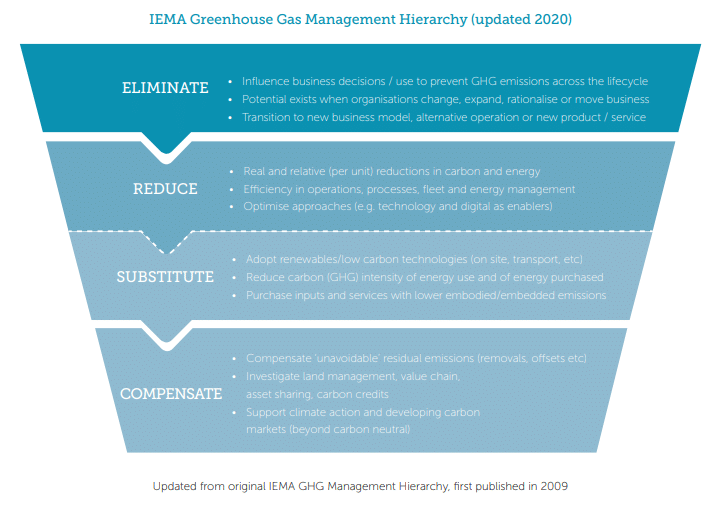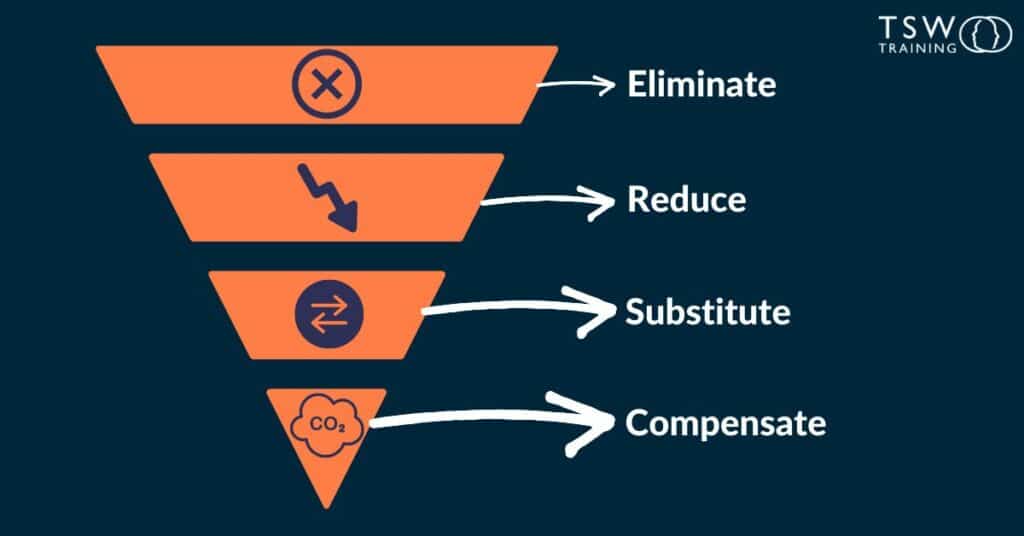One of the greatest known threats to our environment is the release of greenhouse gases (GHGs). Large emissions of GHGs such as carbon dioxide (CO2), methane (CH4) and nitrous oxide (N2O), trap heat in the atmosphere, leading to global warming.
In this article, you’ll learn all you need to know about the IEMA GHG Management Hierarchy and discover what it means for your sustainability strategy.
⏰Key points:
- The impact of global warming is already being witness across the world – through natural disasters, melting icecaps and severe weather.
- Governments, citizens and businesses have all been warned that the time for taking action is now.
- Adopting the IEMA GHG Management Hierarchy to your business’ sustainability strategy can lead your business on the right path towards a greener future.
What is the IEMA GHG Management Hierarchy?
In 2009, the Institute of Environmental Management and Assessment (IEMA) published its first GHG Management Hierarchy, a policy guide focused on tackling carbon emissions.
It sets out four ways through which all organisations can manage greenhouse gas emissions:
#1. Eliminate
Aiming to prevent GHG emissions altogether, supporting organisations to transition to a new business model, alternative operation or a new product or service
#2. Reduce
Aiming to achieve real and relative (per unit) reductions in carbon by increasing efficiency in operations, processes, fleet and energy management, using technology and digital to optimise approaches
#3. Substitute
Adopting renewables or low carbon technologies to reduce the carbon GHG intensity of energy use and of energy purchased
#4. Compensate
Where residual emissions are ‘unavoidable’ this should be balanced with removals or offsets, while supporting climate action and developing carbon markets
The road to net zero
Widespread adoption of the IEMA hierarchy, which was updated in 2014 and again in 2020, is understood to help standardise the approach to managing GHG emissions.

Fig. 2. GHG Management Hierarchy, updated 2020, www.iema.net
This allows different businesses and industries to contribute to the target of a net zero emissions economy by 2050.
But with increased warnings about the window of time available to lessen or slow the effects of climate change, IEMA has stressed that although its GHG Management Hierarchy remains focused on optimum carbon reductions, the climate emergency now requires an escalation of action across all fronts.
How can businesses apply GHG Management Hierarchy to their sustainability goals?
The best way for any business to set sustainability goals and achieve them is through engagement.
A business’s greatest weapon in protecting the environment is its own workforce. A wealth of information is at every sustainability manager’s fingertip in the form of knowledge, data and ideas.
Internal communication is key to getting employees on board when it comes to sustainability. Businesses must encourage staff in all departments and at all levels to work together to achieve a common goal of helping to save the environment.
The IEMA GHG Management Hierarchy helps achieve stakeholder buy-in through by giving a business’s sustainability strategy credibility and a clear roadmap. This can help to prevent accusations of greenwashing.
By referring to the hierarchy, a series of measures can be simultaneously pursued to reduce or even eliminate carbon emissions from the business altogether.
⏰Key point: The sustainability manager in any organisation can be guided by the hierarchy, but it is essential that thorough environmental audits, research, monitoring and reporting is carried out to uncover specific issues and determine the best approach, tailored to the business.
Where can I learn more about the IEMA GHG Management Hierarchy?
IEMA provides a detailed guide on how to use the hierarchy in a Net-Zero briefing paper on its website.
But there is also an opportunity for deeper learning, alongside the chance to build knowledge and green skills, through the IEMA’s extensive range of environmental and sustainability courses.
These IEMA courses, available through TSW Training, are designed to educate and equip workers at all levels of an organisation to help them meet the challenges of sustainability.
As well as shorter courses, there are options to further your learning and even gain qualifications accredited by the IEMA, such as IEMA practitioner.
What challenges does the GHG Management Hierarchy bring?
One of the challenges of using the IEMA GHG Management Hierarchy might be that it pushes businesses towards research, development and innovation. This can drive up business costs in the short to medium term, while the business sources and then adjusts to new processes or even a new product or service.
It is important throughout such a period of change to fully communicate the process with stakeholders. This should prevent them becoming impatient and critical about not seeing instant results. Expectations can be more realistically set by implementing an effective communications strategy, both internally and externally.
Compensation measures may be used in the short term, as part of a science-based strategy, but it is advised by IEMA that these should not displace options in the higher levels of the hierarchy.
However, carbon capture has hit the headlines recently because of its prevalence in the UK government’s environmental plans. Businesses and governments should be driven towards reducing or eliminating carbon, rather than such compensation measures.
With the right attitude and combination of skills and knowledge obtained from the IEMA’s range of environmental management courses, any business can use the hierarchy to its advantage, to become greener, more competitive, enhancing both reputation and profitability.








